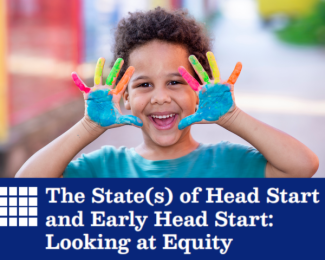
State(s) of Head Start and Early Head Start
Looking at Equity

December 1, 2022
The States(s) of Head Start and Early Head Start: Looking at Equity is NIEER’s second state-by-state report on Head Start and Early Head Start. The report focuses on the 2020-2021 program year and also includes data beginning with the 2011-2012 program year, overlapping with NIEER’s first State(s) of Head Start report that went up to 2014-2015. This new report finds many areas of inequitable access to Head Start but also areas where Head Start is excelling for all children and families. Head Start access, funding, quality, and program components vary across states as well as within states by child race and ethnicity.
Prior to the pandemic, Head Start enrolled just 40% of children in poverty, showing no progress over the last decade despite declines in child poverty, in part due to more children receiving full day services, higher funding per child, and shift of funding to Early Head Start. Early Head Start enrolled 9% of income-eligible infants in toddlers prior to the pandemic, an increase from 4% a decade ago.
Similar to other early childhood education programs, the pandemic hit Head Start and Early Head Start hard with 279,000 fewer children enrolling in 2020-2021. Enrollment has started to rebound but has not reached pre-pandemic levels.
In the report, NIEER highlights additional inequities across states as well as between children of different races and ethnicities within states. We also lay out our recommendations to increase federal funding for Head Start by $10 billion over four years to equalize access to quality Head Start for all children in all states.

Table of Contents
- Full Report
- Executive Summary
- Key Themes
- Covid-19 Pandemic
- Poverty
- Race & Ethnicity
- State Variation
- Guide to the State Profiles
- Glossary
- Endnotes
- National Profile
- State Profiles
- American Indian & Alaska Native Head Start
- Migrant & Seasonal Head Start
- Methodology
- Appendix Tables
- National Press Release / En Español
- Press Briefing (YouTube)
State Profiles
Alabama
Alaska
Arizona
Arkansas
California
Colorado
Connecticut
Delaware
District of Columbia
Florida
Georgia
Hawaii
Idaho
Illinois
Indiana
Iowa
Kansas
Kentucky
Louisiana
Maine
Maryland
Massachusetts
Michigan
Minnesota
Mississippi
Missouri
Montana
Nebraska
Nevada
New Hampshire
New Jersey
New Mexico
New York
North Carolina
North Dakota
Ohio
Oklahoma
Oregon
Pennsylvania
Rhode Island
South Carolina
South Dakota
Tennessee
Texas
Utah
Vermont
Virginia
Washington
West Virginia
Wisconsin
Wyoming
Territory Profiles
American Samoa
Commonwealth of the Northern Mariana Islands
Guam
Republic of Palau
Puerto Rico
Virgin Islands
The Authors
Jennifer K. Duer, Ph.D. is an Assistant Research Professor at the National Institute for Early Education Research (NIEER) at Rutgers University. Her work focuses on both federal and state policies designed to improve the health and development of young children and their families with an emphasis on finance, quality, and prenatal-to-three policies.
Allison Friedman-Krauss is an Associate Research Professor at NIEER where she is also the Associate Director for Policy Research and Director of the Infant and Toddler Policy Research Center.
W. Steven (Steve) Barnett is a Board of Governors Professor and the founder and Senior Co-Director of the National Institute for Early Education Research (NIEER) at Rutgers University. Dr. Barnett’s work primarily focuses on public policies regarding early childhood education, child care, and child development.
Suggested Citation
Friedman-Krauss, A. H., Barnett, W. S., & Duer, J. K. (2022). The State(s) of Head Start and Early Head Start: Looking at Equity. New Brunswick, NJ: National Institute for Early Education Research.



